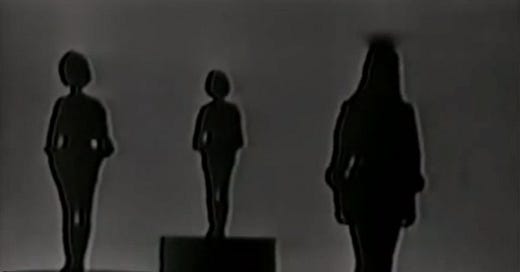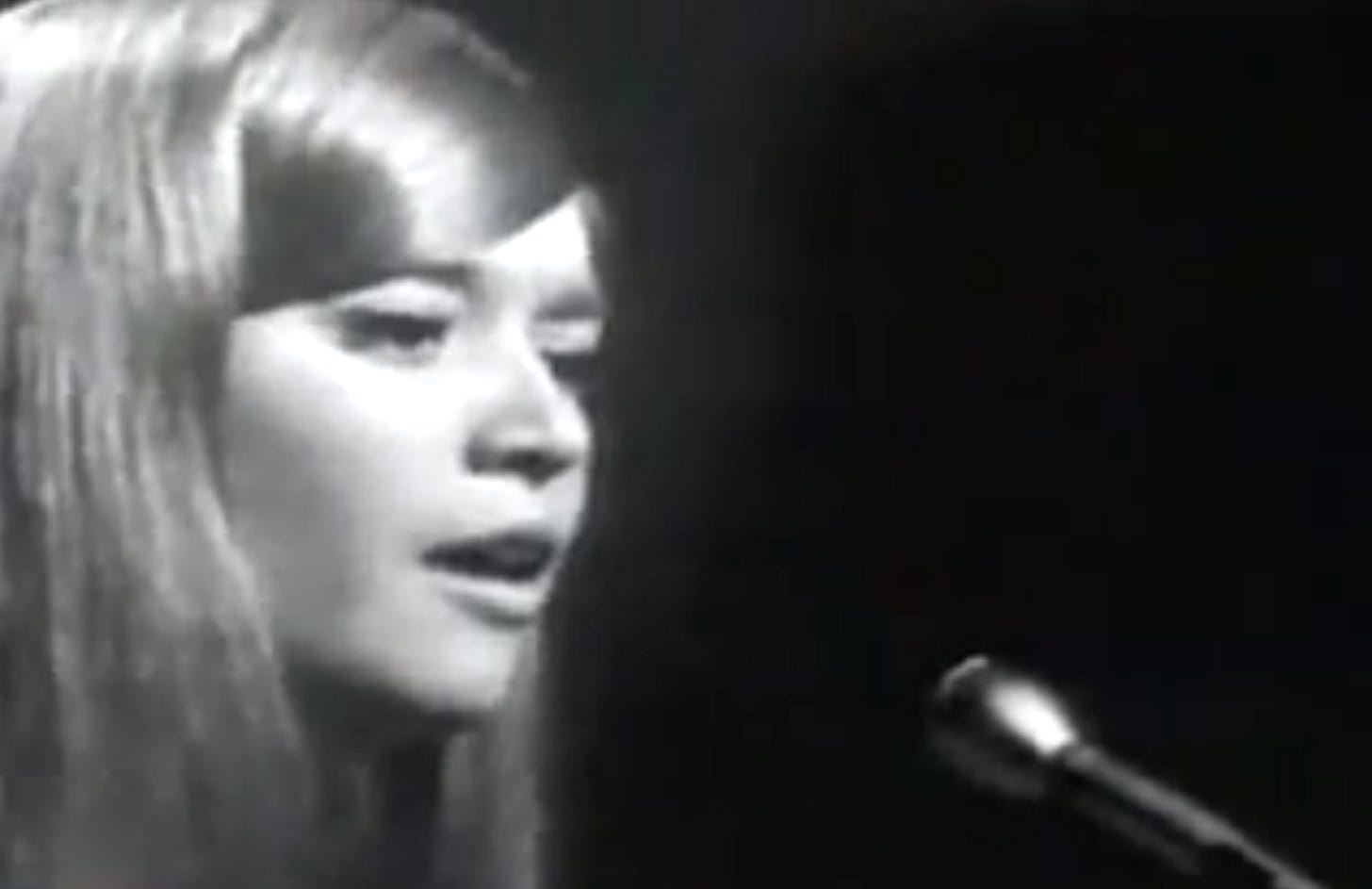In one of the most ebullient archival videos on YouTube, 1960s girl group The Shangri-Las sing a truncated version of their hit song, "Give Him a Great Big Kiss" on Shindig!, a pop music TV show. The group is at its prime, performing their third single to top the U.S. charts since their debut in August 1964. By far the girls’ most upbeat song, “Give Him a Great Big Kiss" is a proto-feminist landmark, depicting female desire in unabashed detail.
The Shangri-Las appear live in front of a horn section and behind a drummer who wears a bemused smile while keeping the beat. The video is dominated by a close-up of lead singer, Mary Weiss, listing her guy's attributes as he walks toward her on the street. It's late April, 1965. Mary, who is about halfway through her rock star career, just turned 16 last December.
The video glimmers deep gray and silver. Sometimes the highlights distort, creating a solarized effect when they get too bright for the camera equipment to handle. The girls are clad in sleek, form-hugging pantsuits belted at the waist. They wear white leather go-go boots and look all kinds of sharp. Street cred is integral to their legend and "Give Him a Great Big Kiss" seals the deal on vinyl, over the airwaves, and in this performance.
Mary breaks the object of her affection — a bad boy from Queens — into a neat set of visuals, sketching out a type easily filled in by the listener’s imagination. Thick wavy hair that's a little too long. Tight pants. Dirty fingernails. He walks with a dance in his step, propelled by his own internal beat. He sings to himself, most likely the Doo Wop practiced on the borough’s street corners. He has a tendency to brood. We can almost see him on the sidewalk. The look on Mary's face as she lists these assets is one of open desire; she enjoys objectifying her man.
One of the twins, Marge or Mary Anne, asks the color of the boy’s eyes. Mary doesn't know. "He's always wearing shades." Mary's sister Betty asks if he's tall. "Well, I gotta look up." When Mary tilts her head and focuses her eyes; we can easily picture the difference in height. The other girls declare in unison they hear this guy is bad. Mary considers the possibility for a second and shakes her head. "He's good bad, but he's not evil."
This "good bad" dichotomy is the kick drum heartbeat of the Devil’s own music. The Shangri-Las live inside the contradiction; good girls gone somewhat bad, bad girls who remain dependably good. In most of their songs, which often trace the forbidden contours of teenage love (and lust), they come off as a little more knowing and dangerous than their rebel boyfriends.
In all their TV appearances, The Shangri-Las enact tiny vignettes for the camera, fully inhabiting their assigned parts. Their is no crack in the facade, no moment of faltering commitment; they are the image they sell so successfully. Each individual might be tough, definitely able to handle herself on mean streets, but they are exponentially more powerful together -- a pack of girls on the corner cannily assessing their prey. The Shangri-Las aren't waiting around for some guy to make the first move.
They all march jauntily in lockstep, singing the chorus in unison: "I'm gonna walk right up to him. Give him a great big kiss. Mwah." As Mary puts her hands to her mouth, there is a quick zoom out that accentuates the kissing gesture, expressing the exhilaration of empowerment, the freedom to choose a love object worthy of her attention.
Though the TV performance doesn't feature it, the single begins with a classic line that has reverberated throughout rock history. Mary asserts: "When I say I'm in love, you best believe I'm in love, L-U-V!" (A few years later The New York Dolls' David Johansen will don a wig and use this same line to open "Lookin' for a Kiss." Other early New York punks (Blondie, The Ramones) will also cop this attitude.)
Mary's voice and facial expressions clearly communicate the power of her intentions. She doesn't care what anyone thinks; she's going to claim the boy she desires. She is serious; her teenage passion is real, physical, and not without its dangers. The single ends with a final question, left out of the Shindig! performance. The other girls want to know if this guy is a good dancer, which seems to confuse Mary. They ask again: "Well, how does he dance?"
She answers: "Close. Very, very close." The emotion in her phrasing communicates the physical nature of her attraction, which has the disturbing potential to consume. Mary draws out the words, expressing the hunger and danger of teenage desire.
This performance lasts less than 2 minutes but contains volumes. The Shangri-Las aren't ordinary girls. At this point in their short career, they have already performed with many of the great musicians of the period; their self assurance is clear. They are tougher, more assertive, and willing to explicitly address issues other “girl groups” only hint at. Less concerned with romance of the love and marriage variety, The Shangri-Las tangled (often tragically) with bad boys who got their motors running.
The group’s harmonies are tight. Mary Weiss's leads are more than just vocal interpretations; they are dramatic readings. Perhaps the familial bond between The Shangri-Las’ two sets of sisters enabled more expressiveness in the studio.
Mary describes herself as born singing: "I sang from the time I could speak. I was always into music. Always. My brother had an extensive record collection and I listened to everything. As far as harmony goes, I knew that's what I was going to do when I was in sixth grade, and The Shangri-Las were an extremely harmony oriented group."
Mary sang every chance she got, performing in school plays, and working out harmonies with her sister Liz, often referred to as "Betty". The Weisses met the Ganser twins in grammar school. "We used to climb trees. Not a very feminine group of people. Lincoln Logs, erector sets, climbing trees, and harmony. We used to sing on the street corners and in bathrooms, in tunnels. Oh, Central Park has some great tunnels if you want to sing harmony. And that's pretty much how we started. We used to do school dances and things. I mean we were too young to do anything else. We actually got a manager." Mary was just fourteen at the time, the youngest in the group.
The Weiss family lived on 220th Street; the Gansers on 219th in Queens, New York. Mary, Betty, and their older brother George helped keep their family together. "My father died six weeks after I was born," Mary told London's Telegraph newspaper in 2007. "He worked for the phone company and they found him dangling from a pole. People who die young never believe in insurance. We had to raise my mother."
Meanwhile, a few blocks away, the Gansers grew up surrounded by music. Their mother sang and played piano in local nightclubs. Identical twins Margie and Mary Ann took piano lessons, learning about music theory and composition; Mary Ann eventually mastered the guitar.
The Weisses and the Gansers ended up at Andrew Jackson High together and quickly got serious about gigging as a vocal group. They soon attracted the attention of a local promoter, the notorious Artie Ripp, who signed them to an exclusive contract with Kama Sutra Productions.
Well, their parents signed the contract, which yielded a couple of unremarkable singles and may have been one of the reasons the girls never received their fair share of the money they earned. The early history of rock and roll is abundant with such stories; gender, race, and class played an outsized role in who reaped the rewards of labor, talent, and the resulting hit singles.
Nonetheless, the connection to Kama Sutra brought the girls to the attention of George "Shadow" Morton, who was the mastermind behind their biggest, most unusual, and consequently most enduring records. The Shangri-Las met Morton while auditioning for another producer and turned out to be ideal vehicles for the radio melodramas that played inside the young producer's head.
This story continues next week.
Sources:
Betrock, Alan. 1982. Girl Groups: The Story of a Sound. London: Omnibus.
Entertainment Tonight. 1989. The Shangri-Las Going to Court.
Fresh Air. 2007. Mary Weiss Comes Back for a ‘Dangerous Game’. Philadelphia: WHYY.
Grecco, John. 2010. Out in the Streets: The Story of the Shangri-Las. Redbird.com
Lieber J. & Stoller M. 2009. Hound Dog: The Lieber & Stoller Autobiography. New York: Simon & Schuster.
MacKinney, L. 2012. Dressed in Black: The Shangri-Las and Their Recorded Legacy, The University of Western Australia. Doctoral Thesis.





